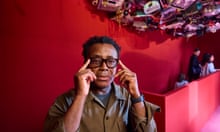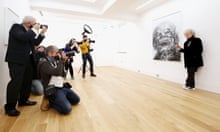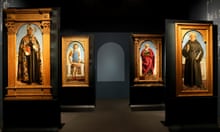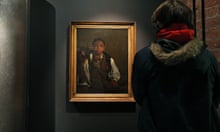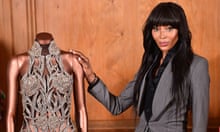When I meet him, artist Oleksiy Sai, along with his wife and son, have slept the night in their studio, a warren of rooms tucked behind an unassuming courtyard in central Kyiv. It’s on the ground floor, and with good walls, so they reckon it’s reasonably safe from Russian rockets. Safer, that is, than their apartment: the previous day they were woken by the juddering scream-boom of cruise missile strikes, one cratering a children’s playground a block from their flat. Somehow, their windows survived, though the glass was blown out of most of the nearby buildings. Now, the whole family is busy making work: his son Vasyl is at a screen editing videos; his wife, Svitlana Ratoshnyuk, is making folksy textiles embroidered with “Fuck Putin” in Ukrainian.
Before the war, Sai – slim, intense, wearing a black hoodie – used to make colourful works, based on Excel software, that wryly commented on “office life and global culture”. But when the Russians invaded on 24 February, he says, “I forgot about art completely, I forgot all my plans and started working for the war.” First, he began rolling out designs for protest posters. “I know how to do it fast,” Sai says; he honed the skill nearly a decade ago, during the 2013 Maidan Square protests against the pro-Russian then president, Viktor Yanukovych. Sai’s banner designs have been seen on the streets of London, New York and Berlin. They are not subtle. “Unilever! Quit Russia!” reads one, the familiar corporate logo rendered as a U-shaped spatter of blood. Another depicts a line of Russian medals “For torture”, “For looting” and “For the genocide of the Ukrainian people”.
Later, Sai made a video work. He shows it to me on his computer. Brutal images march across the screen in a grim procession: shattered and broken bodies, twisted and collapsed buildings, the full Goya-esque horror of war. The raw material for the piece was 7,000 photographs from the conflict’s barbaric heart – gathered from journalists, but also from photographers he knew who had signed up as combatants and taken pictures deep amid the raw carnage. “My goal is to terrify people,” he says. “To show that the war is total. To show that it’s fucking serious.” The work has been shown at the Nato headquarters, at the European parliament. Its sound consists of radio intercepts of Russian soldiers talking to their mothers or girlfriends, along with a sort of dull metronomic beat that gives the whole work a “zombified” feel, as Sai puts it. “It’s too scary for news,” he says. “But for art, it’s possible.” None of the images is captioned, there’s no contextual information; it’s designed to cut to the marrow. It’s certainly not intended to be journalism. As an artwork, “it gives you a deeper emotional connection, and a deeper knowledge”, he says. He calls it “propaganda” before checking himself: “It’s not propaganda. It’s not the stuff I want to do, it’s the stuff I need to do.” He adds: “It is practical and useful, and people changed their minds about the war. It worked.” In the resistance against the Russian invasion, Sai’s art is his weapon.
The work is distressing; after a few moments, to my relief, he pauses the video. I can’t help wondering what it was like to live among these images, studying them, editing them together in his small dark studio. “It was three weeks of hell. I dreamed about them. They got into my head,” he says. He developed a nervous tic, started scratching himself obsessively. For relief, he has been making what he calls his Smoke series of drawings – swirls of black that recall the clouds rising from the site of missile strikes. After Russian attacks, Ukrainian outlets show footage not of the affected buildings, but only the smoke – so as not to reveal whether the intended target was hit. There’s a stack of these Smoke works at the back of the studio; he’s given lots away so they can be sold to raise money for the war effort. “I’m lucky to get to edit in this comfortable place, smoking and eating,” he says. “I won’t lose my leg doing it. It’s easier than firing a gun.”
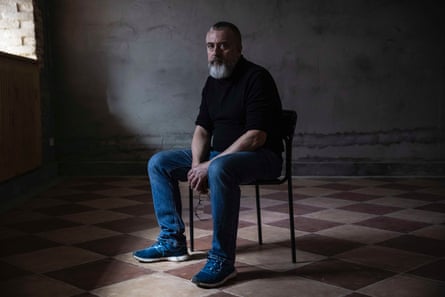
Where to begin a story of war? Every war teems with stories: stories of survival and violence, of resistance and compliance, of struggle and terror. They go together: many of the oldest stories that survive (the Iliad, the Odyssey) are stories of war and its aftermath. The Russian invasion of Ukraine is a war full of stories but also a war about a story, about the accepted facts, about the prevailing narrative. Vladimir Putin’s “special operation”, as he calls it, seems to have been intended to provide a spectacle, a kind of war movie, for domestic consumption, drawing the Russians together against what he hopes to frame as a common enemy – described variously as Nazis, terrorists or even, bizarrely, as the forces of Satan. At the same time, the war’s false justification has its own disturbing narrative, its own warped internal logic. Underlying Putin’s military aggression, as his speeches and essays have for years made clear, is his assertion that Ukraine has no distinct existence – that it can be seen only as an adjunct to Russia. In such a war on a nation’s culture, identity and history, it is artists and cultural figures who find themselves the crack troops of the resistance. The war is on one level about borders, and it is being fought with shells, Himars rocket launchers and Shahed-136 drones. But it is, on a deeper level, about culture. And, desperately holding the line, fighting on the cultural front, weaponising their work, are Ukraine’s artists.
What happens to art when a war appears as an unwelcome guest in your country? In the short term, war ruptures language and meaning; art seems pointless. No one I speak to in Ukraine can forget the shock of the first day of the invasion – a day that is sealed into people’s memories as surely as a fly trapped in amber, to borrow an image from Maksym Kurochkin, a Kyiv-based playwright turned soldier. Musicians tell me how they seemed to fall deaf, in those early days; novelists, how they started to muddle languages they’d never confused before. Art is no use against rockets or guns. “You could not protect your family from a rifle with your poems,” as Oleksandr Mykhed, a writer I meet at a book festival in Lviv, puts it. Everything collapsed in on itself, in those early days.
The best use of words, as the invasion began, was not to arrange them into elegant poetic forms, but to use them to send a message to your friends that you were alive, or to help someone stay safe. Mykhed speaks of a backpack his wife, Olena, has put together, containing equipment to use in the event of a nuclear attack, along with directions. “If the backpack survives, then we have a piece of nonfiction with instructions for restoring life,” he says. On 23 February, the day before the invasion, he finished writing a book. As the tanks rolled in, he volunteered for the military. On the fifth day of the war he was sleeping in barracks. On the seventh, his home was shelled to destruction. In such a way, war renders a life unrecognisable, over the course of a single week.
A few days after the cruise missile attacks on Kyiv, I am at the National Opera of Ukraine watching a ballet rehearsal. In this grand, slightly tatty mirrored and chandeliered hall, the dancers could be dancers anywhere in the world, with their worse-for-wear tracksuits, their stringy elegance and their miraculous but nonchalant physical prowess. It is only the sudden whine of an air raid siren that tells you that it’s Kyiv, and there’s a war. Everyone ignores it, because up till this week, at least, such alerts have usually portended nothing. The next morning, though, the siren that wakes me at 6.25am is followed exactly 12 minutes later by a shower of Iranian Shahed-136 drones that will kill, among other Kyiv residents, a 34-year-old sommelier, who was six months pregnant, and her partner. This afternoon, though, everyone carries on with the rehearsal of Pinocchio as if nothing is amiss, the dancers playing Geppetto and Pinocchio whirling each other round in a glorious pas de deux.
This simple feat of carrying on, despite everything, is a powerful act of resistance in itself. The invasion abruptly stopped the opera house’s work, but, after the Russian withdrawal from the environs of Kyiv, it reopened again this May, staging reduced versions of works, and selling only the stalls seats in case of air raids and a general dash to the basement. In the rehearsal break, I meet ballerina Raisa Bentankourt, still in her fox costume from the Pinocchio run-through. On 24 February she woke to the sound of explosions and the echoing salvo of every car alarm in the neighbourhood. At first: paralysis. “Then, you pull yourself together and with a cold mind think what you have to do to save your child.” She drove west for 27 hours straight with her three-year-old son, through “the scariest night of my life, through traffic jams, past so many accidents on the road”.
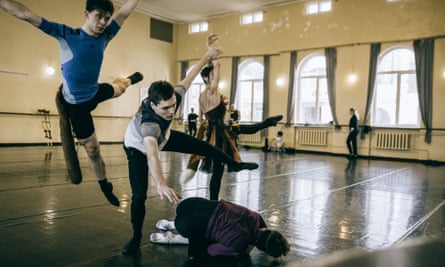

But she has now been back in Kyiv, and dancing, since the theatre reopened. “I was hesitant about whether to return, but then it came to me that I have to perform, I need the audience,” she tells me. “Just as a power station produces electricity, just as a bakery produces bread, a theatre has to keep on performing – because it’s life,” says Viktor Lytvynov, the company’s resident choreographer and the creator of Pinocchio.
I am led down echoing backstage corridors to another rehearsal room where singers are running through the soul-tugging music of act two, scene one of La Traviata, accompanied by a répétiteur on the piano. While waiting for his call, bass baritone Oleksandr Melnychuk tells me that when the Russians invaded, he was with his family in a village near Bucha, north-west of the capital, which they mistakenly thought would be safer than Kyiv. (Bucha was occupied and more than 400 inhabitants killed, the unburied dead strewing the streets.) Almost at once he found himself “manning checkpoints, guarding buildings, building barricades, making molotov cocktails”, as part of the local territorial defence group; he and his fellow defenders watched a Russian convoy roll past on the highway nearby. He’s about to perform the title role in Verdi’s Nabucco, though part of him wishes he was in the army – despite the fact that the previous month the opera house mourned one of its own, a former principal dancer turned soldier, killed at the front. (Oleksandr Shapoval’s photograph hangs front of house with other pictures of Kyiv’s dance stars, past and present; he’s costumed up for a part in Giselle, a far cry from the combat gear of the Ukrainian military.) Nevertheless, Melnychuk says, “I know that I need to perform my duties. I feel that my responsibility is to be here – my responsibility is to the people who come and listen.”

Chief director Anatoliy Solovianenko tells me that he was worried no one would come to the first show in the reopened house, back in May. But it sold out. He went out to the foyer and started asking people why they’d come. “They told me it was because the theatre gave them an opportunity to enter a different world for a few hours – one that’s kind and beautiful.” Insisting on keeping the theatre open despite the war is a way of meeting an urgent and basic human need: for connection, for imagination and for hope.
If art seemed a feeble and useless weapon in the first confused days of the invasion, for many I speak to in Ukraine, that sensation did not last long. If nothing else, the power of the written word as a tool of witnessing and testifying became very clear. Writers such as Mykhed began to keep detailed diaries. Artists, too: the painter and ceramicist who goes by the pseudonym Kinder Album began making daily drawings. “They were immediate and reactive,” she tells me. “I needed to put my emotions on paper, not even in the studio, but in my kitchen when I turned on the radio news.” Artist Andriy Rachinskiy, who’d been living in Kharkiv in the east on the outbreak of war, began documenting painted-out road signs, graffiti and billboards on Instagram.
Film-makers concentrated on documentary. “It’s really important to show that war isn’t things happening on the frontline, it isn’t politics; it’s things happening with ordinary people who are fighting for ordinary life,” says Ivan Sautkin, a member of Babylon‘13, a collective that formed during the Maidan Square protests almost a decade ago. He tells me about one of the characters in the film he’s currently shooting in northern Ukraine – “an 86-year-old lady from the Chernihiv area. During the occupation she was sitting by her window, knitting, as old ladies do – counting the Russian tanks, then sending the information to Ukrainian intelligence.” Novelist Victoria Amelina retrained as a collector of war crimes testimony – a single conversation with an elderly man in Balakliya, a recently liberated town near Izyum in the Kharkiv region, led to the discovery of three Russian torture chambers and more than 75 victims. For her, fiction will have to wait. “There are real people here and their stories have to be told,” she says.

A sense of immediacy fed into music, too: Ukrainian pop has become surreal, dark, funny, defiant, reactive; TikTok is full of young Ukrainian military volunteers, dancing. Poet Lyuba Yakimchuk has made an album with a group of writers and musicians, called Ukrainian Songs of Love and Hate. One of their sardonic, quietly wrathful tracks describes a dream in which Moscow is on fire. “I know my psychiatrist will probably frown / but I keep having the same dream – Moscow’s burning down.” Hard to swallow, perhaps, until you remember what’s burning in the real world is not Moscow, but Ukrainian cities and power stations. Humour is a coping mechanism; so is bleak fantasy. “Laughing at Russians helps. There are lots of memes,” she says.
Of all those I meet in Kyiv, though, it is artist Zhanna Kadyrova who seems best to sum up the potential of art in wartime to be both a practical act of resistance, an immediate reaction to events and, in the end, a poetic response to it. I meet her at her studio in a dilapidated former liquor factory in the centre of Kyiv, where she insists on dusting down a couple of chairs before we sit. Husky-voiced, serious, but with an occasional sudden smile and throaty laugh, she has just returned from a shooting range where she has been firing an AK-47 at large ceramic tiles. Though they would rip through flesh, the bullets merely scar these specially treated tiles – the effect is restrained and postminimal, and she enjoys the contrast between the brutality of the artworks’ making and their almost demure appearance. She’ll sell them to buy flak jackets, cars, anything the Ukrainian army needs. She hadn’t intended to handle the Kalashnikov, but the trainer at the range persuaded her. “You get a gamer’s rush,” she says. “You forget you are carrying a killing machine. At the same time, this is our reality. I need the skill. Everyone here does.”
After the invasion, she got her mother to safety in Germany and then found refuge for herself in Transcarpathia in the far west of Ukraine, near the Hungarian border. There was no electricity in her house there. She and her husband, Denys, chopped wood for heat, and drew their water from a well. “We ran a line through the trees to next door, 100 metres away, to get an internet connection,” she says. Physical labour was a relief: it meant there was no time to read the news obsessively. She found herself going back to the basics of art, making simple portraits of her neighbours, drawing in a way she hadn’t done for years.
after newsletter promotion
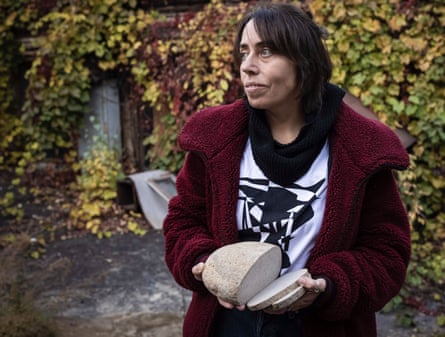

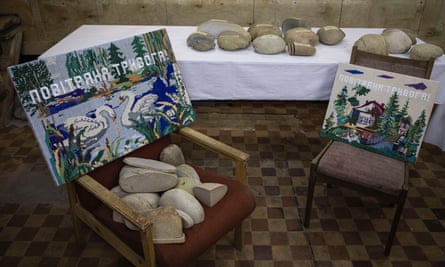
She pulls out a few of the old cross-stitch embroideries she’s been buying, the sort of thing she saw hanging in the village houses, depicting pretty, idealised pastoral scenes – cottages, lakes, swans. Over them, she’s sewn the Ukrainian for “air raid alert” in large letters: the whining sirens even reached her in the rural west, though everyone really did ignore them there. Perhaps the most eloquent work she shows me is a series that she made from the most basic material of them all – smooth round stones she heaved from a Transcarpathian riverbed.
The series is called, and is meant to resemble, palianytsia – a traditional round loaf of bread. The effect is heightened by the fact that the rocks are sliced neatly, as if ready to serve at table – Denys did it using a cheap stonecutter they found in the local supermarket. Palianytsia is a word that Russians find difficult to pronounce in Ukrainian, and so it is a potential shibboleth or giveaway if, say, a Russian saboteur is in your midst. (Videos are in circulation of Ukrainians challenging unrecognised soldiers to say the word.) The idea came to her instinctively; for her, it is unusually autobiographical and direct. “I didn’t have time for reflection; I didn’t think.” She explains: “When people come to your home, traditionally they are welcomed with palianytsia – but this is stone bread. Meaning, we don’t welcome Russians.” From the proceeds of this harsh welcome “we bought flak jacket and bullets, and food for people locally. I exchanged stone bread for real bread.” The work is deadly in its simplicity.
“There’s a feeling of the futility of all this. It’s really hard to find the strength to walk into this water again,” says Natal’ya Vorozhbit, a playwright whose work has been seen at the Royal Shakespeare Company and the Royal Court in Britain. We are talking – near a Kyiv subway entrance, just in case of air raids – about her remarkable play Bad Roads, set amid the chaos and violence that was let loose when Russian-backed separatists took over areas of the Donbas in 2014.
She thinks of Bad Roads, which was performed in London in 2017, as a kind of warning. But it went unheeded: Putin’s aggression was underestimated, and war has rolled in again like a tide. Now she wonders whether art can really change things. “When the field you’re working in is culture, and when you are looking at the neighbouring country, Russia, where once there was the coolest theatre and a pretty cool film industry – well, their culture didn’t help them. Look how fast they dropped back to the middle ages. You start to think whether it’s worth it.”
She has a deadline approaching and wonders aloud how she’s going to meet it, given she’s been sheltering in an underground car park from missile attacks with her daughter. Still, though, she is compelled to go on. “I can’t imagine how artists can reflect on anything else,” she says of the war. “If they do, I don’t believe them. I can’t imagine how Russian artists can ignore the war, either, though they do.” She adds, with a sort of sad determination: “I can’t take up a weapon, so this is what I can do. I can force myself to create.”
I meet her friend and fellow playwright Kurochkin in a new theatre in a basement in central Kyiv – a theatre that represents a potential future cultural life for Ukraine. While we talk, he takes delivery of some new doors: the modest space is gradually taking shape. This is to be a playwrights’ theatre, on the model of new-writing theatres such as London’s Royal Court. When the war broke out, he signed up for the army – he had done two years’ military service before the dissolution of the Soviet Union. He fought at the front in Luhansk this spring – five days defending a position from which he and his unit eventually withdrew. “Those five days were an entire cosmos to me,” he says. “Probably we didn’t help much, but we did what we could. I am proud of my brothers, we fought honestly. Some lost their lives.” It was a moment in which, he says, he was some use as a citizen, but no use – for the time being – as a playwright.
But he will be useful as a playwright, he insists, in the future. He has stories to tell, when he has the right perspective on the horrendous events he has witnessed. “Theatre is a weapon,” he says. He wants to see buildings like this new theatre established round the country “in every major city, to be a platform for discussion”. Theatre, he says, should and could be “an instrument of liberation from the enemy’s system of thinking”. He sees it as a democratic tool that should be right at the heart of political debate, as it was in ancient Athens. He wants the kind of theatre that could have alerted Ukrainians, and the world, to the false narratives purveyed by Moscow during the incursions of 2014. It’s a wildly optimistic view of the power of drama, but what else is there but hope? “I will do everything I can in order for young Ukrainian authors to be heard,” he says. When will the theatre open, I ask. “The day after the victory – except I’ll have a hangover then,” he says. Then he corrects himself. “No, we’ll start before that.”
Kurochkin’s insistence on the emergence of a new Ukrainian theatre has a wider context. During this war, Ukrainians are sloughing off what they describe as centuries of cultural colonisation by first the Russian empire, then the Soviet Union. At times this colonisation has operated subtly, through a Soviet belittling of Ukrainian culture as essentially childish, a matter of drunken peasants in Cossack trousers. But it has also been pursued brutally and cruelly, by, for example, actively proscribing writing in Ukrainian as at times under the tsars; or through mass bloodshed, as when hundreds of Ukrainian writers and artists, known as the executed renaissance, were killed under Stalin in 1937.
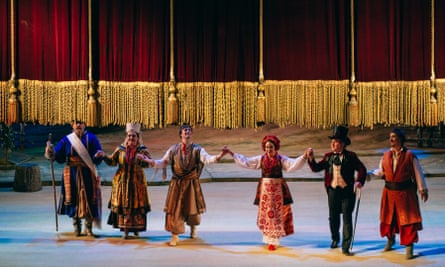
In the current war, Ukrainian culture is seen to be a specific Russian target: observers point to the shelling of a museum devoted to Maria Prymachenko early in the conflict. The country’s favourite 20th-century artist, admired by Picasso, she made gloriously colourful paintings of fantastical scenes and imagined creatures in a deceptively naive style. In occupied Kherson, rumours abound of museums emptied out by the Russians; and there are numerous examples of Ukrainian cultural heritage damaged or destroyed, such as the striking medieval sculptures known as “babas” on Mount Kremenets, near Izyum. At the same time, Russian culture is being blatantly instrumentalised by the occupiers to justify the invasion: billboards erected in Kherson proclaimed the city’s links to Russia’s national poet, Pushkin.
Under these circumstances, Ukrainians are brushing aside Russian culture in favour of reclaiming and rebuilding their own. At the Ukraine National Opera, for example, there is no Mussorgsky or Tchaikovsky on the playbill, no Swan Lake or Sleeping Beauty – but I saw a performance of Natalka Poltavka, a charming comic opera by the 19th-century Ukrainian composer Mykola Lysenko, whose sandbagged statue stands in the courtyard outside. “Stravinsky is my favourite composer but, while Russia uses its culture as a weapon, I will not listen to him,” composer Ihor Zavhorodnii tells me when I visit him in his apartment on the outskirts of Kyiv. “If we could separate Russian art from what we have now, which is politics and rockets, I would say, yes, let’s play Tchaikovsky. But we cannot.”
Like the playwrights, Zavhorodnii understands that his task, in the end, is to resist the invasion by relentlessly creating. “The problem of our history of art is that the generations have been interrupted repeatedly,” he says. He tells me about composer Vasyl Barvinsky, whose manuscripts were publicly burned by the NKVD (Soviet secret police) in 1948 when he was condemned to 10 years in the gulag; after his release and rehabilitation, he spent the last five years of his life trying to reconstruct his lost scores. There is so much art in Ukraine that was lopped off at the root, that never got the chance to grow and flourish, says Zavhorodnii. But, he insists, “We are now in a place where our culture cannot be interrupted. I have focused on composing, for the long perspective. We have to think of our culture like capital – we have to invest in it.”
“Something great can appear,” as poet Lyuba Yakimchuk puts it. “We had a Ukrainian renaissance once and now it can be the same. You feel this energy; there are a lot of stories created by this war. We need to write them. People can grow after trauma – and it can happen with a society, too. I believe we will create something new.”

